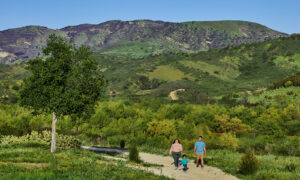Irvine residents are exceptionally healthy, according to several surveys, and one likely reason lies outdoors, in the city’s more than 270 parks and tens of thousands of acres of permanently preserved open space.
Spending time in nature is good for both your body and mind – so much so that some scientists say it should become a habit, just like brushing your teeth. Of course, it helps if the toothbrush is close at hand.
“Not everyone can travel to remote wilderness, and it’s actually not really necessary,” says Lisa Nisbet, associate professor of psychology at Trent University in Canada. “Just getting outside in a park for a few minutes a day can really lift your mood, and who doesn’t want to be happier?”
Nisbet is one of dozens of researchers throughout the world who’ve been compiling evidence of nature’s health-enhancing gifts. These include not just the obvious physical ones, such as fresh air, cool shade, and opportunities to exercise, but a surprising array of mental and emotional benefits. Dozens of studies suggest that even brief but regular amounts of immersion in natural settings can improve people’s health, lowering blood pressure, reducing anxiety and depression, and improving concentration.
The benefits of grassy knolls and sunset strolls
There’s every indication that Irvine residents are taking advantage of the sights and scents of the city’s woodlands and lakes.
Remote workers bring their laptops to grassy knolls along the Jeffrey Open Space Trail. Newlyweds pose under sycamores along an adjacent creek. Couples take sunset strolls around the 9-acre lake at Mason Regional Park in the heart of the city, while hikers explore the park’s 123 acres of wilderness trails.
“Irvine spends more on its park system than almost any city in the country, which shows how much Irvine cares about ensuring the health and welfare of its residents,” says Will Klein, the project manager for parks research at the Trust for Public Land. The national nonprofit has repeatedly ranked Irvine in the top 10 of the 100 largest U.S. cities, based on acreage, upkeep and other factors.
Healthy environments are by design
The city’s green spaces were indeed designed with residents’ health in mind, says Irvine Company landscape architect Richard Roy. The team that planned the Jeffrey Open Space Trail, which features an irregular creek-bed path made of decomposed granite, was inspired by New York’s Central Park, one of America’s first major attempts to offer urbanites peaceful green havens for quiet contemplation, Roy says.
“It’s still very rare in suburban settings to be able to experience natural landscapes like this,” he says.
Inspired in part by scientists’ findings, government leaders throughout the world are becoming more interested in expanding and maintaining “green infrastructure.” The United Nations has set a goal of providing universal access to safe and accessible public green spaces by 2030.
Lucky Irvine residents won’t have to wait. Says Klein, at the Trust for Public Land: “No matter where you live in Irvine, almost everyone has a park within a 10-minute walk from home.”










